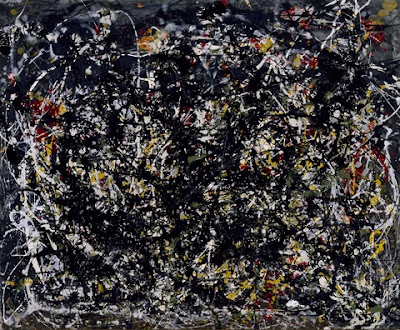Wow, that was a messy lecture. So, let me follow up with some explanation...
We watched
The Gleaners and I by Agnes Varda to demonstrate how our creative process can be understood as
assembling source material (Rembrandt, cabbage, cats, one's hands, etc.) and
recontextualizing or re-appropriating it (making mold into art, organizing this mess of disparate things into a narrative).
We discussed the
process of signification in which our
experiences are organized into
conceptual categories, that these
concepts are referred to with the use of
signs (marks on a page, uttered sounds, etc.), that those
signs denote and connote certain things. Add to that the understanding that any sign only has meaning when compared/contrasted with other signs, and we see that this process of signification is a rather tenuous one (Think about it--You look up a word in the dictionary and you're given more words which you must look up in the dictionary, etc., etc.) Acknowledging the fluidity of meaning--the gaps between experiences and concepts, concepts and signs, texts and readings--is recognizing the
play in language.
We watched
Rip! A Remix Manifesto by Brett Gaylor to see the historical precedent for the deliberate acknowledgment and incorporation of play in creative work. Bluesmen like Muddy Waters, Robert Johnson and Son House took existing songs (or signs or representations), read them in certain ways, reworked them according to their readings, and re-produced them. Their work (and all creative work, if you think about it) is comprised of both themselves (the artists) and their influences.
This week's creative project addresses that, but rather than simply remake something, I want you to use this exercise in play to understand yourself better. So, to be clear, here are some steps to follow...
- Pick an aspect of your identity--I am a male. I am white. I am a husband. I am a father. I am a teacher. Etc., etc. Pick one that you think will be interesting to you and to us.
- Find a mediated representation of this aspect of your identity--Representations of masculinity in Led Zeppelin's 'Whole Lotta Love'. Representations of whiteness in I Love Lucy. Representations of fatherhood in Family Circus comics. Representations of teachers in Frederick Wiseman's documentary High School. Whatever.
- Now engage with that representation--In what ways does this accurately represent your understanding and performance of this aspect of your identity? In what ways does it not? For example, I might find High School's representations of some teachers as harsh disciplinarians who enforce students' adherence to prescribed gender roles to be problematic. But I also might identify with the English teacher who uses Simon and Garfunkel to illustrate how aesthetic decisions contribute to the communication of theme. Your engagement will have similar complexity.
- Now, manipulate that representation to illustrate your engagement with how it represents your identity--I'll give you a few examples.
L.H.O.O.Q. by Marcel Duchamp
Duchamp's taken Da Vinci's Mona Lisa, drawn a mustache on it and included the caption "L.H.O.O.Q." (which in the French pronunciation resembles a mild sexual innuendo). Now, why would Duchamp do this? As a
Dadaist, Duchamp was interested in questioning the role that art plays in society, and his art intentionally reflects his challenge to the authority of high art (like Da Vinci's). So, while he identified as an artist, he found problematic what the Da Vinci's work communicates about what art is or should be. So, he defaced it--and this manipulation of the image is representative of his engagement with this aspect of his identity.
The Grey Album by Danger Mouse
(FYI, there may be language in the following clip that some might find problematic).
Danger Mouse has taken the Beatles' White Album and Jay-Z's Black Album and created a series of sample-based songs called the Grey Album. Why would Danger Mouse (Brian Burton) do this? Well, because of his mixed racial and cultural heritage, and the role that both rock and hip hop played in his development as a musician, this approach to music (of genre, culture, etc.) represents his engagement with the hybrid nature of his identity as an artist and as a human being.
Concession by obsession_inc
Take a look at it
here.
obsession_inc has authored a fan-fiction novel based on the character Christine Everhart (the Vanity Fair journalist Tony Stark has a one night stand with during the first
Iron Man film). Why would she do this? Well, superhero comics and their film adaptations have been generally pretty sexist--female characters are marginalized and/or objectified, often lack power and agency, and are often in need of saving. (As if you need evidence--go back and watch
Spiderman 2 and count the number of shots that include screaming women--you'll be amazed.) So, a narrative set in a comic book universe which focuses on empowered female characters is an attempt to introduce some more balanced representations of femininity into the genre.
There you go. Come to class Wednesday with questions about the assignment. I'll be evaluating your projects with these things in mind:
- your selection of aspect of identity, your selection of textual representation
- your creativity and critical thinking in your manipulation of the text
- your thoughtfulness in the artist's statement (re: your selection of text, consideration of representation, aesthetic choices in your manipulation of the text)
- your reflection of the experience sharing your work online
- your having followed directions
















